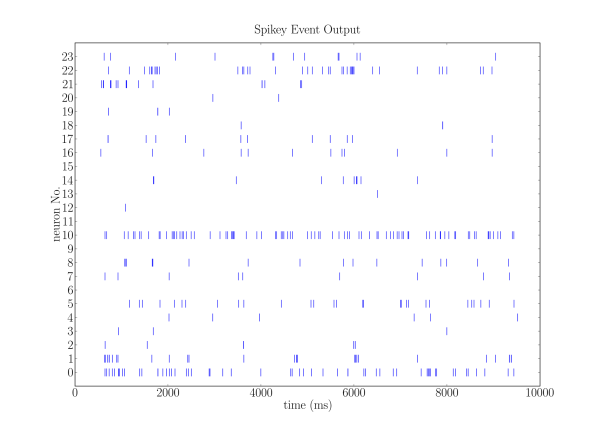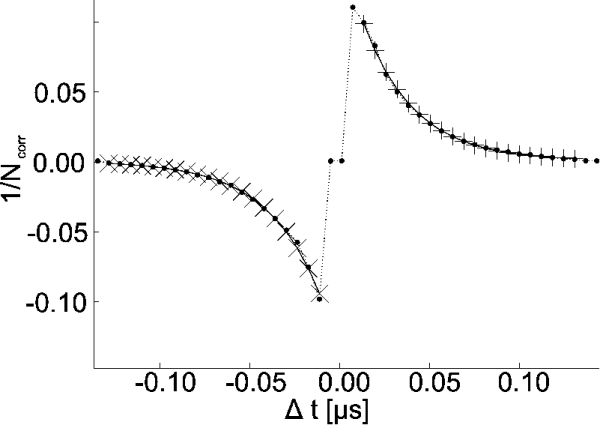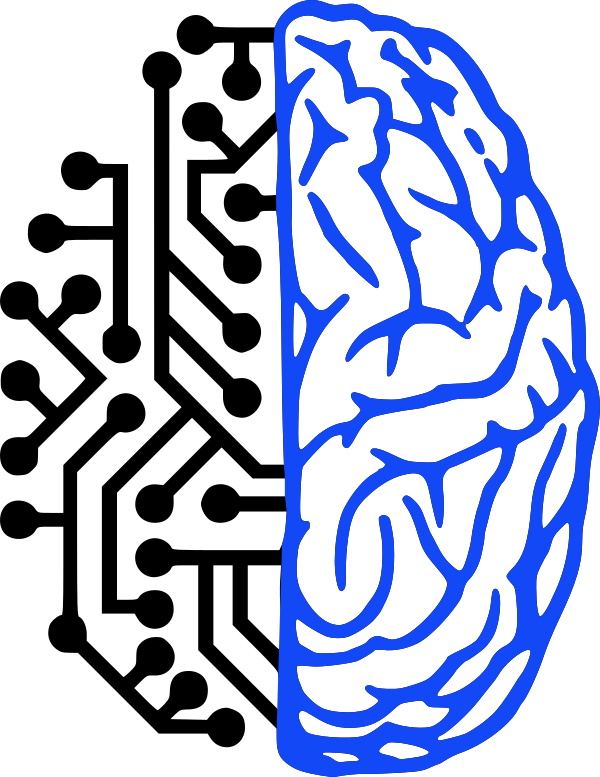Before experiments of neuroscientific relevance can be performed on the FACETS hardware, it has to be assured that the silicon substrate behaves as homogeneous as possible. Every electronic circuit has to be tested and specified, and inhomogeneous transistor properties due to production process variations have to be counterbalanced by calibration routines.
Since, between biological neurons, information is exchanged via so-called spikes (or action potentials), their temporal patterns of occurance is the main feature to be reproduced correctly by every kind of spiking neuron model.

A so-called rasterplot of spike times as measured at 24 different neuron circuits in the FACETS hardware. The time scale is already converted to simulated biological real time, i.e. the real experiment duration was 200 usec (with a speedup factor of 50.000).
Still, these spike times are determined by the course of the neurons' membrane potentials, and thus the voltage traces emulated by the electronic circuits on the FACETS hardware also have to be included into any calibration flow. As a reference for correct analog behavior, the software simulator NEST with the same underlying neuron model as for the hardware is used.

Top: The course of a membrane potential under synaptic stimulation over time, recorded at a neuron circuit in the FACETS hardware. Bottom: The membrane potential as calculated by a numerical software simulation for a corresponding model neuron under the same input as the hardware neuron above. Note the different time scales!

A Software Framework for Tuning the Dynamics of Neuromorphic Silicon Towards Biology
Daniel Brüderle, Andreas Grübl, Karlheinz Meier, Eilif Mueller, and Johannes Schemmel
Springer LNCS 4507 pp. 479 - 486
A neuron will do just nothing without synaptic stimulation. But furthermore, a neural networks capability of learning and self-organization lies in its synaptic plasticity, i.e. the ability to change its synapses' weights. In the FACETS hardware, every synaptic circuit implements a biologically realistic learning rule called Spike Timing Dependent Plasticity (STDP).
An STDP synapse connecting neuron A with neuron B will get stronger, if both neuron A and neuron B fired and the time difference Δt between the spike times is such that the correlation between the spikes could have been causal. if only an acausal correlation is possible, the synapse will be weakend. A hardware STDP curve showing the dependence of that strengthening respectively weakening on Δt can be seen below.

A Software Framework for Tuning the Dynamics of Neuromorphic Silicon Towards Biology
Daniel Bruederle, Andreas Gruebl, Karlheinz Meier, Eilif Mueller, and Johannes Schemmel
Springer LNCS 4507 pp. 479 - 486
Modeling Synaptic Plasticity within Networks of Highly Accelerated I&F Neurons
Johannes Schemmel, Daniel Bruederle, Karlheinz Meier, Boris Ostendorf
Proceedings of the 2007 IEEE International Symposium on Circuits and Systems
Electronic Visions Group – Prof. Dr. Johannes Schemmel
Im Neuenheimer Feld 225a
69120 Heidelberg
Germany
phone: +49 6221 549849
fax: +49 6221 549839
email: schemmel(at)kip.uni-heidelberg.de
How to find us


